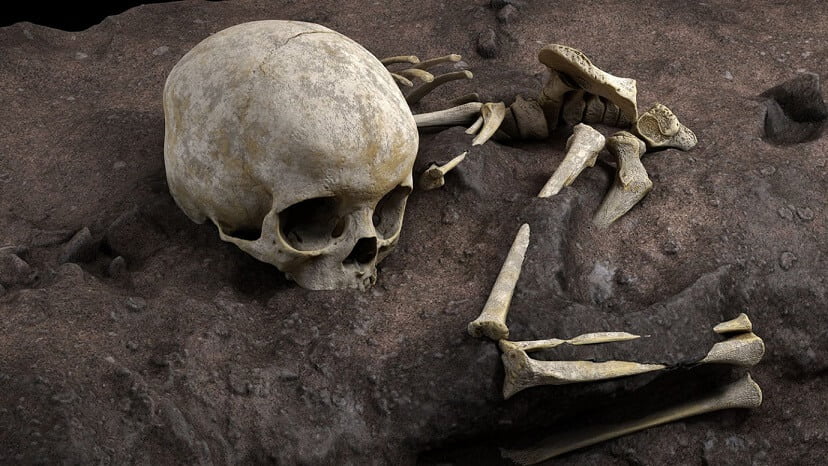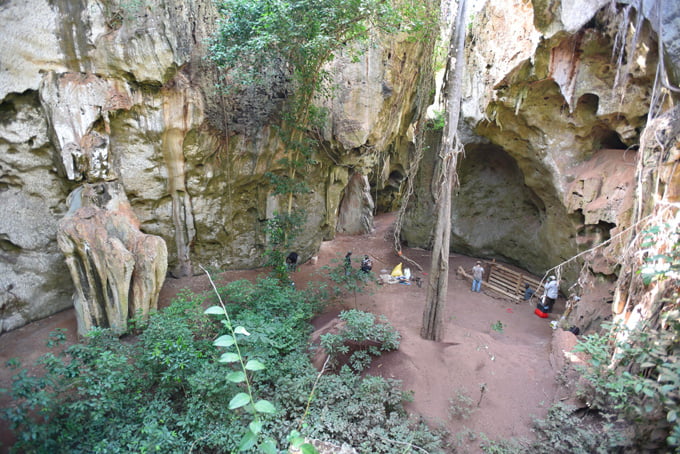
A Child’s 78,000-Year-Old Grave Marks Africa’s Oldest Known Human Burial
Excavations at Panga ya Saidi pushed back the ritual’s date at least a few thousand years
By Bruce Bower | Science News
A child whose lifeless body was carefully placed in an East African cave around 78,300 years ago has made a grand return.
Researchers who unearthed the ancient youngster’s remains say that they’ve found the oldest known intentional human burial in Africa. The investigators, who report the discovery in the May 6 Nature, have named the ancient youngster Mtoto, a Swahili word that means “child.”
“Mtoto was buried in a sheltered part of a cave that was repeatedly occupied by people over a span of nearly 80,000 years, up to about 500 years ago,” said archaeologist Michael Petraglia of the Max Planck Institute for the Science of Human History in Jena, Germany, at a May 3 news conference. Local people still visit this spot to worship and conduct rituals.
Mtoto’s discovery suggests that “a tradition of symbolically significant burials, at least for the very young, might have been culturally embedded in parts of Africa” toward the end of the Middle Stone Age, which ran from around 320,000 to 30,000 years ago, writes bio-archaeologist Louise Humphrey of the Natural History Museum in London in a comment published with the new paper.
Excavations at Panga ya Saidi, or PYS, a cave site located in forested hills about 15 kilometres from Kenya’s coast, revealed Mtoto’s grave. Petraglia and Max Planck archaeologist Nicole Boivin led work there starting in 2010.
Preliminary signs of Mtoto’s burial appeared in 2013. Digging revealed part of a shallow pit, but fragmentary bones visible in the pit were too fragile to remove or study closely. Stone tools typical of Africa’s Middle Stone Age had turned up in the same sediment, giving researchers a sense of how old the bones were. Lab analyses indicated that the sediment had last been exposed to sunlight about 78,300 years ago.
Investigators excavated the entire pit in 2017 and covered it in plaster for transport to the National Museums of Kenya in Nairobi. There, researchers noticed that two teeth in the pit looked human.

Excavations at this African cave site called Panga ya Saidi revealed the continent’s oldest known example of an intentional human burial. Mohammad Javad Shoaee
The plastered pit was then sent to paleoanthropologist María Martinón-Torres at the National Research Centre on Human Evolution in Burgos, Spain. After removing plaster around the earthen block, her team used CT imaging to create digital versions of the PYS bones, revealing a Homo sapiens child’s partial skeleton. Fossil positions indicated that the child had been placed on his or her right side, with knees bent up toward the chest. Many bones were intact enough to be removed from the pit.
The size and development of the two teeth in the pit indicated that the child had died at age 2.5 to 3 years. Microscopic study of the fossils and chemical analyses of pit sediment indicated that the child’s body was interred soon after death, before decomposition began. That explains why parts of the child’s skeleton remain well-preserved, including a skull base connected to three neck bones.
Special care was taken in burying Mtoto, Martinón-Torres said. For instance, the skull base and attached neck bones had collapsed away from other back bones in a way suggesting that the child’s head originally lay on a support or pillow that had decayed. Rotation of a collarbone and two ribs suggested that Mtoto’s upper body had originally been wrapped in a shroud.
An infant found in a pit inside southern Africa’s Border Cave in 1941 has previously been cited as Africa’s earliest burial. But evidence for that argument remains uncertain, Petraglia said. The Border Cave infant dates to between 74,000 and 58,000 years ago.
Even if it’s true Mtoto is the oldest burial in Africa, more Middle Stone Age burials have been found in Eurasia and the Middle East than in Africa. Humans were buried in an Israeli cave more than 90,000 years ago (SN: 10/29/03). And Neandertals may have buried their dead in an Iraqi Kurdistan cave 60,000 to 70,000 years ago (SN: 2/18/20).
Mtoto and the possible Border Cave burial fit a Middle Stone Age pattern in Eurasia of regularly interring infants and children in public spots, says archaeologist João Zilhão of the University of Barcelona, who was not involved in the study. After around 30,000 years ago, Eurasian infants and children were buried in remote locations (SN: 5/8/99), unlike teens and adults, he says. It’s not clear why age-related differences in the treatment of the dead occurred at that time.
Many Middle Stone Age Africans may have buried the dead of all ages away from living areas, not in caves where people continued to live, says archaeologist Lyn Wadley of University of the Witwatersrand in Johannesburg, who also was not involved in the study. If that’s the case, finding more African burials from Mtoto’s time will most likely be a challenge. “Open-air burials are not easy to find and preservation is likely to be poor,” she says.
This article was originally published by Science News.
